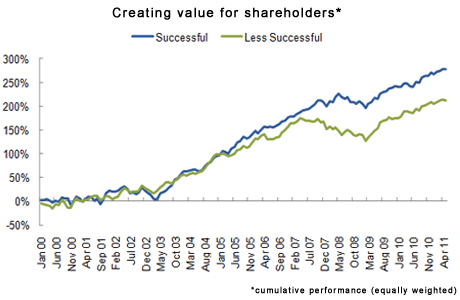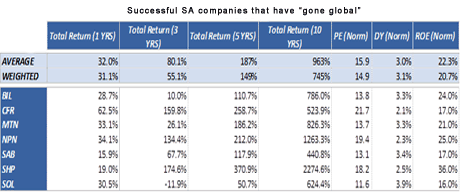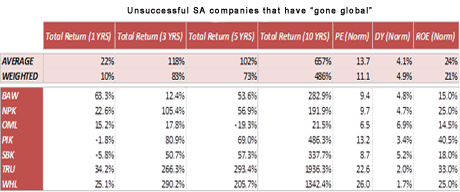The Successes And Failures Of Local Companies Going Global

Successful capital allocation by management (part custodians of wealth creation) is the cornerstone of future wealth creation. Allocating capital to projects that exceed your cost of capital will ultimately create more value for shareholders (and result in the intrinsic value of a company increasing over time). In South Africa, we have had mixed results from management teams, some of whom have created enormous value for shareholders and others (sadly) who have destroyed an enormous amount of value. In this short piece, we examine some of the successes and some of the failures. Note: some of the failures have by no means been totally disastrous. Management teams need to be given the “freedom” to explore opportunities – and some will be successful and others won’t. You don’t want to suppress management’s appetite for taking risk, provided they don’t “bet the farm” on potentially risky expansions.
We have compiled a list of South African companies and divided them up into “successful” global expansion and “unsuccessful” global expansion. This is not meant to be an exhaustive list, but rather to express a few key points. In many instances (not all), the companies classified in the “unsuccessful” global expansion category have, in fact, very strong local franchises. However, due to factors that we will explore below, they have not been able to translate their local success into global success. This does not mean that they are poor investments. In many cases, the mistakes that the companies have made are already priced into the stocks and, provided management teams are pragmatic about future capital allocation, they could prove to be great future investments (we discuss this further in the analysis). Companies that have been enormously successful include: SABMiller, MTN, Naspers, Billiton, Richemont, Sasol and Shoprite.* What are some of the differentiating factors (not necessarily relevant to all) that have contributed to their success?
(*Note: this is not an exhaustive list of “successful” companies that have gone global, rather it is a sample for us to deliberate on why they’ve been successful. Likewise, our list of “unsuccessful” companies is a sample.)
- Strong brands (relevant to all)
- Dominant market positions (relevant to all)
- Low cost of production (Billiton in particular)
- Scale benefits:
- Linked to cost of production above
- Procurement advantages – power over suppliers (MTN, SABMiller, Billiton, Shoprite)
- Being “first to market” (MTN, Naspers)
- Strong management (in most cases)
- Technological advantages (SOL, Naspers)
- Focus: specialisation (SABMiller, MTN, Richemont, Sasol, Shoprite)
What is mostly common about the above factors are the following: strong management and strong brands with dominant market positions. In most of these instances, management has been able to export their competitive advantages. They tend to have sustainable “moats” (competitive advantages).
On the other hand, companies that have been less successful (and in many instances unsuccessful) in “going global” have faced some similar challenges:
- Fragmented (and highly competitive) markets
- Low market shares
- Commoditised products
- Little or no scale benefits
- Lack of strategic vision (often points to management)
The list (not exhaustive) of South African companies that have had challenges with their global strategies and have largely been “unsuccessful” include: Woolies (Country Road), Truworths (Sportsgirl), Pick n Pay (Franklins), Barloworld (Scientific Group, Hyster), Nampak (UK packaging), Old Mutual (US Life & Asset Management) and Standard Bank (Russia and South America). Interestingly, there are three retailers in this list. In fact, we could name another list of retailers that have been spectacularly unsuccessful in their global exploits (remember Pepkor’s low cost clothing venture in the UK – Brown and Jackson and Nuclicks’ venture into Australia (Priceline)? What is glaringly common across all of these examples is the lack of scale (market share), brand strength and highly fragmented markets (difficult to achieve dominance). The other common link (more incidental I guess) between most of the retailers’ ventures internationally have been their entry into Australia – take note if you see another one make an attempt!
We spend a great deal of time evaluating the business economics of a company, the quality of management and the intrinsic value of a business. The return from an investment is inextricably linked to the price that you pay (entry level), the business economics and management’s ability to allocate capital efficiently (reinvestment of capital into value accretive opportunities). What is clear from the chart below is that businesses with strong business economics and good management teams are likely to create value for shareholders faster than the average business over time. On an equally weighted-and market-cap weighted basis, the “successful” basket of stocks outperformed the “unsuccessful” basket by 65% and 100% respectively.

That, however, is what happened in the past – where to from here? In this regard, we need to point out that we own a few companies in both categories. In the “successful” category, we own SABMiller, MTN, Sasol and Billiton. These are fantastic businesses with great management teams that are still offering some upside to our assessment of fair value. In the past, we have owned Richemont, Shoprite and Naspers. These are also extremely well managed businesses with exceptional business economics. However, we currently cannot justify owning them from a valuation perspective (refer to the table below). In contrast, even though the companies in the “unsuccessful” category have disappointed with respect to their global initiatives, many of their local franchises remain strong and in certain instances the valuations look appealing. From the list of “unsuccessful” companies (in terms of their globalisation strategy), we own Barloworld, Nampak, Pick n Pay, Standard Bank and Old Mutual. Much of their global disappointments have been discounted into their current valuations (see below). In most instances, they have either rectified past “mistakes” or in the process of dealing with their past “mistakes”. The clothing retailers, on the other hand, remain too expensive in our opinion on a “normalised” earnings and cash flow basis.


In summary, an assessment of a company’s business economics and the strength and strategic vision of management, especially with respect to the allocation of capital, is crucial to assessing whether it will potentially create value for shareholders. But at the same time, don’t forget that your ultimate returns come from the price you are willing to pay, not the price at which you sell!





Comments are closed.